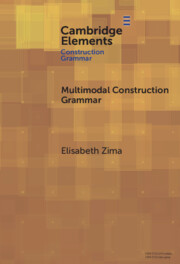Refine search
Actions for selected content:
138 results

Multimodal Construction Grammar
-
- Published online:
- 25 August 2025
- Print publication:
- 25 September 2025
-
- Element
-
- You have access
- HTML
- Export citation
Taking a stance with pragmatic borrowings: English response tokens in Finland-Swedish podcast conversations
-
- Journal:
- Nordic Journal of Linguistics , First View
- Published online by Cambridge University Press:
- 22 August 2025, pp. 1-25
-
- Article
-
- You have access
- Open access
- HTML
- Export citation
9 - Public English
- from Part II - Constructing Languages through Discourses on Belonging, Prestige, and Materiality
-
- Book:
- Liquid Languages
- Published online:
- 28 July 2025
- Print publication:
- 14 August 2025, pp 195-224
-
- Chapter
- Export citation
Heritage speakers’ perception of heritage speech: prosody contributes to heritage accent more than segments do
-
- Journal:
- Bilingualism: Language and Cognition , First View
- Published online by Cambridge University Press:
- 15 July 2025, pp. 1-13
-
- Article
-
- You have access
- Open access
- HTML
- Export citation
6 - Acquisition of Welsh Phonology
- from Part II - Acquisition of Phonology and Phonetics
-
-
- Book:
- The Acquisition of Celtic Languages
- Published online:
- 03 July 2025
- Print publication:
- 10 July 2025, pp 109-130
-
- Chapter
- Export citation
5 - Phonology
-
- Book:
- The Balkan Languages
- Published online:
- 31 May 2025
- Print publication:
- 26 June 2025, pp 359-494
-
- Chapter
-
- You have access
- Open access
- HTML
- Export citation
Plains Cree Word Prosody Revisited
-
- Journal:
- Journal of the International Phonetic Association , First View
- Published online by Cambridge University Press:
- 18 June 2025, pp. 1-42
-
- Article
-
- You have access
- Open access
- HTML
- Export citation
Prosodic Disambiguation of Disjunctive Declaratives and Disjunctive Questions in Jordanian Arabic
-
- Journal:
- Journal of the International Phonetic Association / Volume 54 / Issue 3 / December 2024
- Published online by Cambridge University Press:
- 16 June 2025, pp. 974-1005
-
- Article
-
- You have access
- Open access
- HTML
- Export citation
Raised and in-situ preverbal foci: A unified prosodic account
-
- Journal:
- Journal of Linguistics , First View
- Published online by Cambridge University Press:
- 28 April 2025, pp. 1-34
-
- Article
-
- You have access
- Open access
- HTML
- Export citation
12 - Charismatic Speech Breathing
- from IV - Persuasion and Algorithms
-
-
- Book:
- Manipulation, Influence and Deception
- Published online:
- 10 June 2025
- Print publication:
- 24 April 2025, pp 250-276
-
- Chapter
- Export citation
Chapter Four - Speech Production
-
- Book:
- The Neuroscience of Language
- Published online:
- 17 April 2025
- Print publication:
- 10 April 2025, pp 70-90
-
- Chapter
- Export citation
Prosody and head gestures as markers of information status in French as a native and foreign language
-
- Journal:
- Language and Cognition / Volume 17 / 2025
- Published online by Cambridge University Press:
- 31 March 2025, e42
-
- Article
-
- You have access
- Open access
- HTML
- Export citation
Actually: function, position and prosody
-
- Journal:
- English Language & Linguistics , First View
- Published online by Cambridge University Press:
- 18 March 2025, pp. 1-29
-
- Article
-
- You have access
- Open access
- HTML
- Export citation
14 - Insubordination at the Interaction of Discourse, Grammar, and Prosody
- from Part IV - Multimodality and Construction Grammar
-
-
- Book:
- The Cambridge Handbook of Construction Grammar
- Published online:
- 30 January 2025
- Print publication:
- 06 February 2025, pp 354-383
-
- Chapter
- Export citation
18 - Constructions and Language Contact
- from Part V - Constructions in Sociocultural and Typological Variation
-
-
- Book:
- The Cambridge Handbook of Construction Grammar
- Published online:
- 30 January 2025
- Print publication:
- 06 February 2025, pp 469-496
-
- Chapter
- Export citation
Tuning in to the prosody of a novel language is easier without orthography
-
- Journal:
- Bilingualism: Language and Cognition , First View
- Published online by Cambridge University Press:
- 04 February 2025, pp. 1-10
-
- Article
-
- You have access
- Open access
- HTML
- Export citation
Chapter 6 - Visual Culture
- from Part II - Aesthetic and Cultural Contexts
-
-
- Book:
- Gerard Manley Hopkins in Context
- Published online:
- 16 January 2025
- Print publication:
- 16 January 2025, pp 51-59
-
- Chapter
- Export citation
Chapter 33 - Journal Prose
- from Part VI - Form, Genre, and Poetics
-
-
- Book:
- Gerard Manley Hopkins in Context
- Published online:
- 16 January 2025
- Print publication:
- 16 January 2025, pp 284-291
-
- Chapter
- Export citation
Chapter 25 - Rhythm
- from Part VI - Form, Genre, and Poetics
-
-
- Book:
- Gerard Manley Hopkins in Context
- Published online:
- 16 January 2025
- Print publication:
- 16 January 2025, pp 219-227
-
- Chapter
- Export citation
Prosodic variation between contexts in infant-directed speech
-
- Journal:
- Journal of Child Language , First View
- Published online by Cambridge University Press:
- 13 January 2025, pp. 1-23
-
- Article
-
- You have access
- Open access
- HTML
- Export citation
